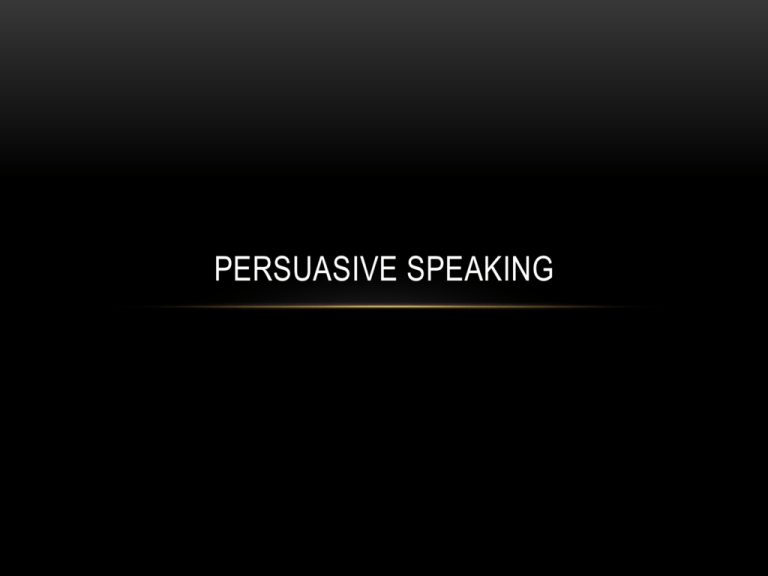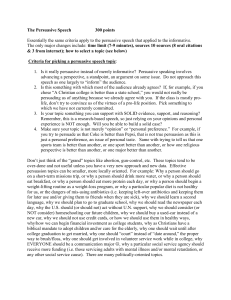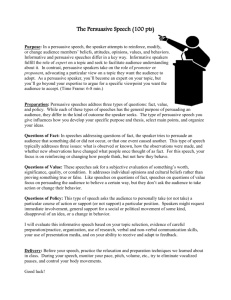Persuasive Speaking
advertisement

PERSUASIVE SPEAKING HOW IS PERSUASIVE SPEAKING DIFFERENT FROM INFORMATIVE SPEAKING? There are seven major differences… FIRST DIFFERENCE • Informative speeches reveal options. • Persuasive speeches urge listeners to make a choice between these options. SECOND DIFFERENCE • Informative speakers function as teachers. • Persuasive speakers function as advocates. • ad-vo-cate [noun]: a person who speaks or writes in support or defense of a person, cause, idea, etc. THIRD DIFFERENCE • Informative speakers offer supporting material to illustrate and clarify points. • Persuasive speakers offer evidence to justify advice. FOURTH DIFFERENCE • Informative speakers don’t ask for much commitment from their audience. • Persuasive speakers ask for audience commitment. FIFTH DIFFERENCE • Credibility is important for informative speaking. • Credibility is very, very, very, very important with persuasive speaking. SIXTH DIFFERENCE • Informative speaking uses few emotional appeals. • Persuasive speaking uses more emotional appeal. SEVENTH DIFFERENCE • The ethical obligation for informative speakers is important. • The ethical obligation for persuasive speakers is more important. EMOTIONAL TARGETS • Sex: the desire to be attractive to, and to attract others • Conformity: the desire to appear and behave like others • Wealth: the desire to possess, earn, save and invest money (assets) • Pleasure: the desire to feel good; to experience happiness, joy and pleasure • Personal Growth: the desire to examine life, explore different aspects of selfhood, and ideally, make strides toward growing as a human being THE PERSUASIVE PROCESS Awareness Understanding Agreement Enactment Integration AWARENESS • Demonstrating the problem “Teenage drivers are responsible for a disproportionate number of motor vehicle accidents.” UNDERSTANDING • Listeners begin to grasp what you are telling them • “Teenage drivers are involved in motor vehicle accidents three times as often as drivers 20 years old and older.” • “Teenagers are more prone to engaging in risky behaviors thus increasing their chances of being involved in injury-related and fatal car crashes.” AGREEMENT • Listeners begin to affirm the speakers message • “Yes, this is a problem!” • “Something must be done about this!” ENACTMENT • The move from acceptance to action • Listeners make a commitment • To act on your call to action, or • To reaffirm or change a belief or attitude about the topic INTEGRATION • The new beliefs, attitudes or actions of the listener begin to mesh with their existing beliefs and values • Your ideas must fit comfortably within their belief system • Lasting change becomes evident TYPES OF PERSUASIVE SPEECHES SPEECHES THAT FOCUS ON FACTS • • • Did something occur? • Common in legal system (was a crime committed or not?) • Did Hillary Clinton violate official State Department policies by using her personal email account during her time as Secretary of State? Does something exist? • Is childhood obesity an increasing problem? • Does Iran have the capability to produce nuclear weapons? Will something occur (or how likely is it to occur)? • Will President Obama succeed with implementing his initiative to provide students with two years of community college for free? • Will an asteroid strike the earth in the next 100 years? SPEECHES THAT FOCUS ON ATTITUDES, BELIEFS AND VALUES • Concentrate on adjusting attitudes or beliefs as they relate to underlying values • “Killing animals for food is immoral, therefore you should become a vegetarian.” • “The United States has a moral obligation to stop tyranny and injustice.” • “The inhumane treatment of animals is a tragedy and therefore you should support animal rights by donating to Hope Ranch Animal Rescue in Malibu.” SPEECHES THAT ADVOCATE ACTION AND POLICY • Propose a plan to fix a problem • Demonstrate the consequences of both acting and not acting • “Teenagers are responsible for a disproportionate number of motor vehicle accidents. Therefore, the legal driving age should be raised to 18.” • “In 2011, 23% of automobile accidents involved the use of cellphones. Therefore, you should turn your phone off while driving.” • “Binge drinking among college students is associated with increased incidences of injury and death. Therefore, colleges and universities should enact stricter alcohol abuse enforcement policies.” ARGUMENTATION SEQUENCE DATA • The problem • “Binge drinking among college students is a serious problem.” CLAIM • What do you want your audience to believe, support, advocate for, do, etc.? • “Colleges and universities should adopt stricter policies to reduce alcohol consumption among students.” WARRANT • The “hard evidence” that justifies the claim • “Approximately 4 out of 5 college students consume alcohol.” • “About half of these students report having engaged in binge drinking.” • “In 2011, over 500,000 students between the age of 18 and 24 received unintentional injuries while intoxicated.” • “An even more devastating statistic reveals that 1,825 students in this same age group died as a result of binge drinking.” A FEW IMPORTANT TIPS… AUDIENCE MEMBERS MUST SEE A BENEFIT FROM CHANGING • You, as the speaker, must explain why making the change will benefit your audience • Can benefit audience members personally • Or can benefit the world around them ASK FOR SMALL CHANGE • People are naturally resistant to change • We are more likely to make small changes than big changes • Example: It is easier to change the type of toothpaste we use, than to change our religious beliefs PROVIDE SPECIFIC INSTRUCTIONS ON HOW TO MAKE A CHANGE • Make it easy for your audience to change the attitudes, beliefs or behaviors! • The easier it is to make the change, the more likely your audience is to do it! ORGANIZING YOUR PERSUASIVE SPEECH SPEECH OF REASONS APPROACH Claim: You should drink more water I. Drinking water helps you lose weight II. Drinking water helps your skin stay healthy III. Drinking water helps prevent cancer PROBLEM-SOLUTION APPROACH Claim: You should donate blood I. There is a shortage of blood supply worldwide (problem) II. Donating blood can help to increase the much needed supply of blood (solution) III. Therefore, you should donate blood (be sure to provide specific instructions on how to help with the solution) CRITERIA-SATISFACTION APPROACH Claim: You should buy a Toyota I. You need a car that meets these criteria: a. b. c. II. It must be affordable It must be safe It must have a good warranty Toyota vehicles satisfy this criteria because: a. b. c. They are affordable (provide evidence) They are safe (provide evidence) They have great warranties (provide evidence) NEGATIVE APPROACH Claim: You should quit smoking I. Smoking increases your chance of heart disease II. You are spending a lot of money on cigarettes III. Smoking makes your clothes smell bad IV. Therefore, the best solution is to quit smoking MONROE’S MOTIVATED SEQUENCE APPROACH I. (Attention) One in three American adults is overweight. II. (Need) Being overweight leads to heart disease, cancer, diabetes and it is unattractive. III. (Satisfaction) Eating healthy can help you lose weight and avoid disease. IV. (Visualization) Imagine looking great and feeling healthy! V. (Action) I want you to start eating healthy!




